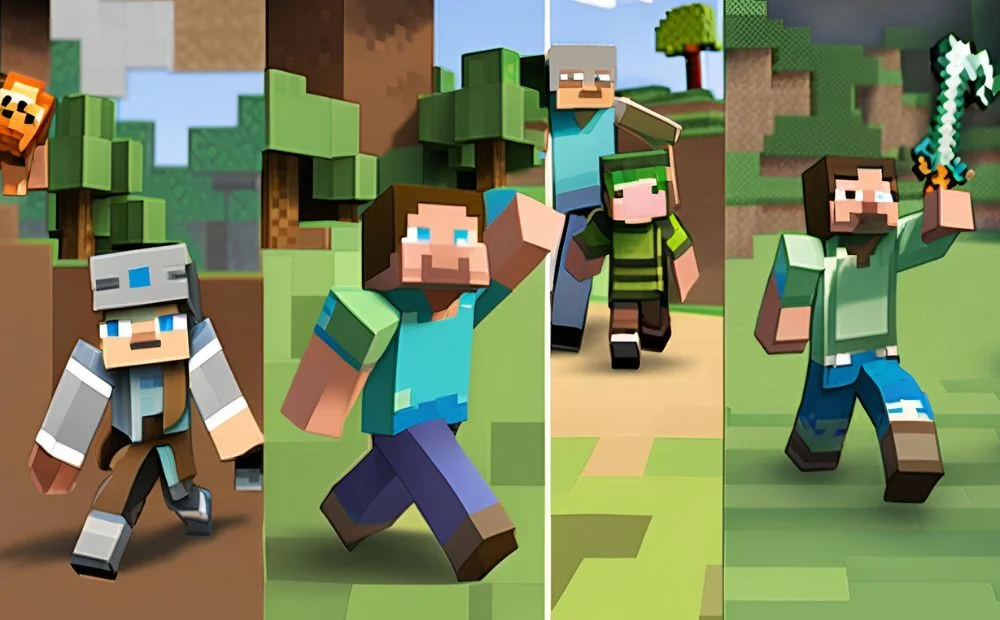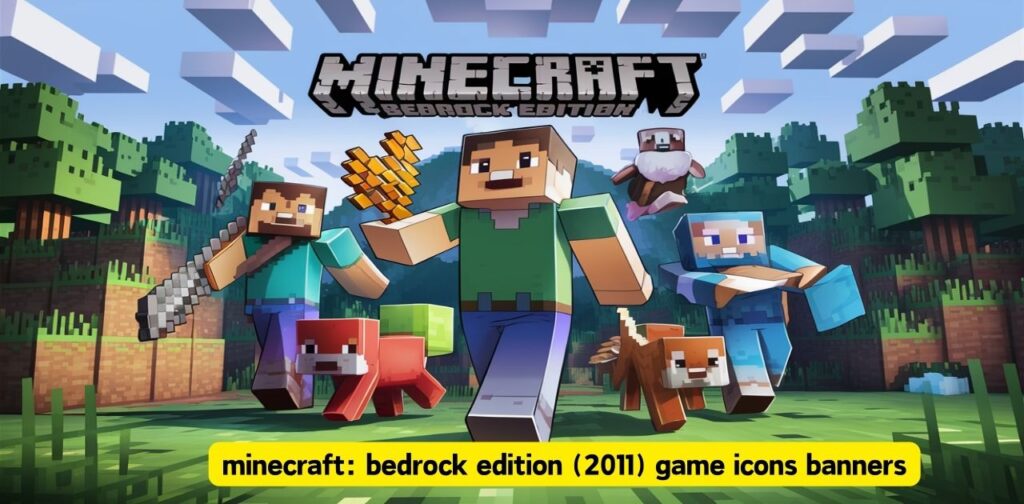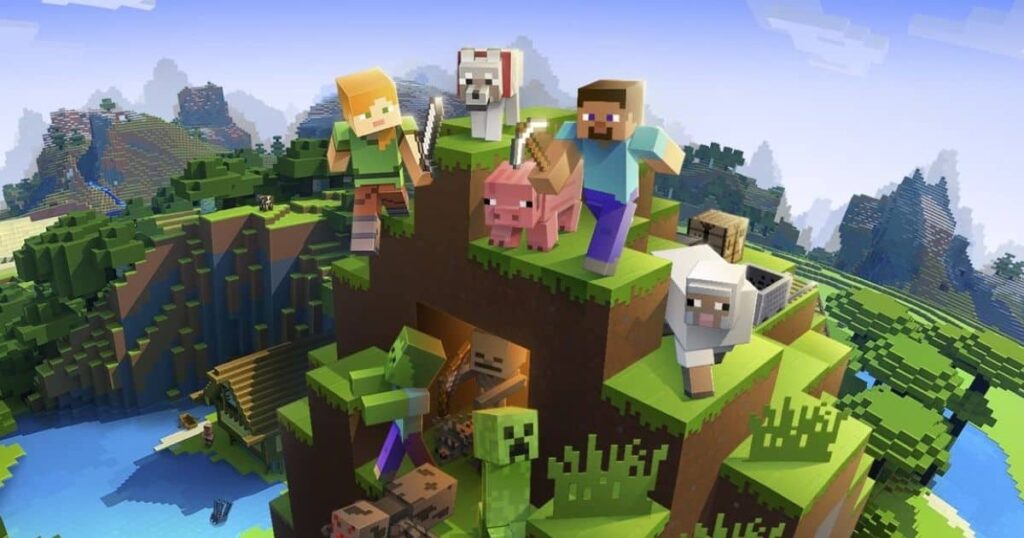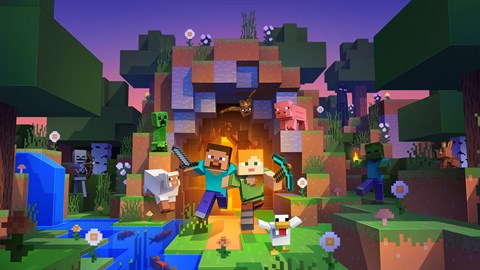Introduction: Minecraft’s Visual Journey
Minecraft has seen a constant evolution since its release, and its visual identity has played a significant role in this journey. From simple beginnings to becoming a gaming titan, the game’s icons and banners have transformed dramatically, reflecting updates and engaging players continuously. This article explores the fascinating evolution of Minecraft’s Bedrock Edition game icons and banners, showcasing their transformation from simplistic designs to the visually stunning creations we see today.
Early Icons and Banners: The Genesis
Initial Years: 2011-2013
2011 – The Beginning: Minecraft’s Bedrock Edition, initially known as Pocket Edition, debuted in 2011. The first game icon was a simple grass block, perfectly encapsulating the game’s core concept of building and exploration. This minimalist approach matched Minecraft’s pixelated charm, making it instantly recognizable.
The early banners were straightforward, featuring the Minecraft logo and a few in-game screenshots. These gave players a glimpse into the sandbox world, highlighting the creative possibilities.

2012-2013 – Establishing Identity: As the Pocket Edition gained popularity, the visual identity began to refine. The game icon saw subtle improvements with better textures and shading, offering a more polished look across devices. This period also introduced the Minecraft title on icons, cementing brand recognition.
Banners became more dynamic, showcasing various environments and characters like Steve, the default avatar. These visuals depicted mining, building, and battling, inviting players into the expansive Minecraft universe.
Also read, halo (2003) game icons banners.
Middle Years: 2014-2016
2014 – Cross-Platform Expansion
With Minecraft’s Bedrock Edition expanding to consoles like Xbox and PlayStation in 2014, maintaining a cohesive visual strategy across platforms was crucial. The game icon was refined to ensure clarity on both small and large screens.
Banners evolved, featuring more detailed scenes and improved graphics to reflect the game’s advancements. Multiplayer interactions and complex builds were highlighted, emphasizing Minecraft’s community aspect. Animated banners began to appear, adding a new layer of engagement.
2015 – Maturity and Recognition
By 2015, Minecraft was a leading title in the gaming industry. The game icon evolved into a polished representation of the grass block, with enhanced textures and vibrant colors appealing to both new and veteran players.
Banners during this time focused on showcasing extensive updates and new features. Visually rich, these banners kept players informed and excited about Minecraft’s continuous evolution.
Expansion Era: 2016-2018
2016 – Cross-Platform Unification
In 2016, Minecraft aimed for a seamless cross-platform experience by unifying its editions under the Bedrock Engine. The game icon was updated with detailed textures and shadows, creating a three-dimensional effect suitable for multiple devices.
Banners emphasized the new cross-platform capabilities, depicting players interacting across different devices within the same world, reinforcing the game’s unified nature.

2017 – The Better Together Update
The “Better Together” update in 2017 marked a significant milestone, allowing cross-play between various platforms. The game icon received a modern makeover with brighter colors and a polished look.
Banners showcased the diverse platforms available, featuring characters interacting in shared worlds. The visual style improved, with dynamic compositions and vibrant colors capturing the game’s creative essence.
2018 – The Aquatic Update
The “Aquatic Update” in 2018 introduced underwater biomes, new mobs, and improved water physics. The game icon retained its 2017 design with slight tweaks.
Banners focused on underwater exploration, vibrant coral reefs, and sea creatures. Detailed artwork and immersive scenes highlighted the update’s depth and beauty, engaging players with the new content.
Must read, treeleftbig.shop.
Current Trends: 2019-Present
2019 – The Village & Pillage Update
The “Village & Pillage” update in 2019 added new villagers, structures, and the hostile Pillagers. The game icon remained vibrant, subtly incorporating elements from the update.
Banners featured scenes of village life and the Pillager threat, highlighting the game’s interactive environments and expanded gameplay dynamics.
2020 – The Nether Update
The “Nether Update” in 2020 transformed Minecraft’s core dimensions, adding new biomes, mobs, and blocks. The game icon stayed consistent, while promotional banners took on a darker theme to reflect the Nether’s atmosphere.
These banners showcased new biomes and mobs, with detailed and contrasting colors capturing the Nether’s dangerous beauty. Animated banners added excitement and visual interest.
2021 – The Caves & Cliffs Update
The “Caves & Cliffs” update in 2021 revolutionized Minecraft’s underground and mountainous terrain. The game icon subtly reflected the adventurous spirit of the new landscapes.
Banners highlighted majestic mountains and sprawling cave systems, depicting players exploring new environments and interacting with new mobs. The visual style was immersive, sparking curiosity and adventure.

2022 – The Wild Update
The “Wild Update” in 2022 brought enhancements to the Overworld, adding new biomes like the Deep Dark and Mangrove Swamp. The game icon incorporated subtle changes to stay current and appealing.
Banners for the Wild Update were vibrant and detailed, showcasing new biomes and their inhabitants. These visuals aimed to draw players into Minecraft’s expanded world.
2023-Present: Community and Legacy
From 2023 onwards, Minecraft’s Bedrock Edition has continued to build on its legacy with regular updates and community-driven content. The game icon remains a symbol of enduring appeal, while banners have become more community-centric, featuring player creations and collaborative events.
Recent banners highlight official updates and community contributions, celebrating the creativity and diversity of Minecraft’s player base. These visuals foster a sense of shared experience and community spirit.
For information about digital transactions visit Wuvisaaft.
Conclusion: Capturing Minecraft’s Essence
Minecraft’s game icons and banners have been crucial in capturing the game’s essence. From simplistic beginnings to the current blend of nostalgia and innovation, these visual elements have shaped the game’s brand identity and kept players engaged. They continue to encapsulate the spirit of exploration, creativity, and adventure at the heart of Minecraft, telling visual stories that engage players and promote the game’s continuous evolution.
As Minecraft evolves, its visual identity will remain a fundamental part of its success, capturing the hearts and imaginations of players around the world.

FAQs: Minecraft: Bedrock Edition (2011) Game Icons and Banners
1. What are Minecraft game icons?
Game icons in Minecraft are small images that represent items, blocks, or entities in the game. They are used in inventories, chests, and item frames to help players identify and organize their resources.
2. What are banners in Minecraft?
Banners are decorative blocks that players can customize with various patterns and colors. They can be placed on walls, shields, and other structures to enhance the visual appeal of Minecraft worlds.
3. How have Minecraft’s game icons evolved since 2011?
Since 2011, Minecraft’s game icons have evolved from simple, pixelated designs to more polished and detailed representations. The icons have retained their recognizable blocky aesthetic while incorporating modern enhancements like dynamic lighting and shading.
4. How can I create custom game icons in Minecraft: Bedrock Edition?
To create custom game icons in Minecraft: Bedrock Edition, follow these steps:
- Choose an image you want to use as an icon.
- Use an image editor to resize the image to 64×64 pixels.
- Import the edited image into the game using resource packs.
5. What materials do I need to create banners in Minecraft?
To create banners in Minecraft, you will need:
- Wool
- Dye
6. How do I customize banners in Minecraft?
To customize banners in Minecraft:
- Place wool in the crafting table to create a blank banner.
- Apply dye to the banner to create patterns.
- Experiment with different dye combinations to create unique designs.
7. What are some examples of popular Minecraft banner designs?
Popular Minecraft banner designs include:
- Creeper Face Banner: Use green dye and the Creeper Charge pattern.
- Gradient Banner: Apply multiple dyes in layers for a gradient effect.
8. How can I use banners in Minecraft?
Banners can be used in Minecraft by:
- Placing them on walls for decoration.
- Attaching them to shields to create custom designs.
- Using them to mark locations or structures in your world.
9. What role do game icons and banners play in Minecraft’s visual identity?
Game icons and banners play a crucial role in Minecraft’s visual identity by:
- Enhancing the game’s aesthetics and making it more visually appealing.
- Reflecting the game’s updates and new features.
- Helping players personalize their in-game experience.
10. How have Minecraft’s banners evolved over the years?
Minecraft’s banners have evolved from simple logo displays to dynamic and detailed visuals that showcase the game’s new features, environments, and community creations. They now often include animated elements, making them more engaging.
11. Can I find community-created icons and banners for Minecraft?
Yes, you can find community-created icons and banners on various Minecraft forums and websites like Planet Minecraft. These resources offer a wide range of designs and customization options created by fellow players.
12. How do animated banners work in Minecraft?
Animated banners in Minecraft are used primarily in promotional materials and updates. They depict in-game activities like building, farming, and battling mobs, adding a layer of excitement and engagement by visually representing the rich gameplay experience.
13. What updates have significantly influenced Minecraft’s game icons and banners?
Significant updates that have influenced Minecraft’s game icons and banners include:
- The Better Together Update (2017)
- The Aquatic Update (2018)
- The Village & Pillage Update (2019)
- The Nether Update (2020)
- The Caves & Cliffs Update (2021)
- The Wild Update (2022)
14. How can I stay updated on new banner designs and game icons?
To stay updated on new banner designs and game icons, follow Minecraft’s official social media channels, forums, and community websites. Additionally, checking for updates within the game and participating in community events can keep you informed about the latest designs.
15. What is the importance of visual storytelling in Minecraft’s banners?
Visual storytelling in Minecraft’s banners is important because it:
- Engages players by depicting in-game activities and updates.
- Serves as a powerful marketing tool, generating excitement for new content.
- Reflects the evolving nature of the game and its community-driven experiences